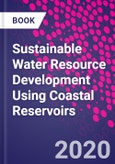Coastal reservoirs are viewed in many regions of the world as an emerging concept of storing fresh water when the river basin is in flood. Similar reservoirs (or impoundments) can be used to generate tidal renewable energy and/or provide the catalysis for urban regeneration. Constructed near the coast in natural river basins, these reservoirs have a smaller environmental footprint and are less obstructive than inland dams. Written by an international group of Civil, Environmental, and Geotechnical Engineers, Sustainable Water Resource Development using Coastal Reservoirs discusses the latest research and breakthroughs in their use, while offering expert advice into their sustainable design and construction.
The perfect reference for researchers exploring the feasibility of this emerging technology or experienced professionals who wish to implement this technology as a water scarcity solution or a tidal renewable energy source or for urban regeneration, Sustainable Water Resource Development using Coastal Reservoirs provides an expert resource to the design, construction and use of coastal reservoirs. The reference begins with a brief but readable examination of water quantity, quality design and geotechnical considerations. The book includes international case studies to clearly illustrate the various uses, design, planning, construction, and operation methods. These case studies include projects such as: Afsluitdijk in the IJsselmeer, (Netherlands), Zuiderzee (Netherlands), Thanneermukkom Bund (India), Sihwa (South Korea), Saemangeum, (South Korea), Chenhang (China), Plover Cove (China), and Marina Barrage (Singapore).
Please Note: This is an On Demand product, delivery may take up to 11 working days after payment has been received.
Table of Contents
1. Introduction to CR2. Water quantity and design considerations of coastal reservoirs3. Water quality considerations: From catchment to coastal reservoir4. Geotechnical considerations5. From Dujiangyan to Qingcaosha6. Insights into the design and development of Shanghai coastal reservoirs7. Preliminary feasibility study for Australian coastal reservoirs8. Coastal Reservoirs in Developed Countries, and their Potential for Urban Regeneration and Energy Supply9. Impacts of Climate Change on Coastal Infrastructure10. Challenges and Opportunities for Coastal Reservoir Development in India11. An alternative method to solve the water crisis in Adelaide apply a coastal reservoir strategy in the Lower Lakes12. Analysis on the water quality remediation strategies for a coastal artificial sea lake13. Future direction
Authors
T.G. Sitharam President, International Association for Coastal Reservoir Research (IACRR), Professor, Department of Civil Engineering and KSIIDC Chair Professor in the area of Energy and Mechanical Sciences, Indian Institute of Science, Bangalore, India. Prof. Dr. T.G.Sitharam is a KSIIDC Chair Professor in the area of Energy and Mechanical Sciences IISc and Senior Professor (HAG Scale) at the Department of Civil Engineering, Indian Institute of Science, Bengaluru. He was former founder Chairman of a Center for Infrastructure, Sustainable Transport and Urban Planning (CiSTUP) at IISc. He is presently the Chairman, AICTE South western zonal committee, Regional office at Bengaluru and vice president, Indian Society for Earthquake Technology (ISET). He was also a Visiting Professor at Yamaguchi University, Japan, and ISM Dhanbad, Jharkhand.He had earlier completed his Masters from Indian Institute of Science (in 1986) and Ph.D. from University of Waterloo, Waterloo, ON, Canada (1991).
Over the last 25 years, he has carried out seismic microzonation of urban centers in India and also developed innovative technologies in the area of fracturing and geotechnical applications, leading to about 500 technical papers, seven books, three patents, 100 consulting projects and two startup companies. He guided 27 Ph.D. and 25 Masters students and trained several postdoctoral and several thousand industry professionals and teachers through continuing education workshops.
His work has been recognized by Indian Geotechnical Society (IGS) through IGS-Kucklemann award in 2015 and by IIT Roorkee through Prof. Gopal Ranjan research award in 2014 for his life time contributions in Geotechnical Engineering. He was also a recipient of Sir CV Raman Young Scientist Award in engineering sciences in 2002 and recipient of many other awards. He is the chief editor of two international journals in his areas of research. Shu-Qing Yang Associate Professor, School of Civil, Mining and Environmental Engineering, University of Wollongong, NSW, Australia. Shu-Qing Yang obtained his PhD from Nanyang Technological University, Singapore, and is currently Associate Professor in the School of Civil, Mining and Environmental Engineering at the University of Wollongong, NSW, Australia. Prior to this appointment, he was Professor and Chair Professor in Korea Maritime University and South China University of Technology, respectively. His research interests include fluid mechanics, hydraulics, sediment transport, drag-reduction with polymer additives, and water resources engineering. He was a chief investigator for sedimentation problems in the Three Gorges Dam, one of the largest dams in the world. He also helped the initiation of coastal reservoirs in many countries including Shanghai, China-one of the megacities with severe water shortage caused by pollution. Roger Falconer Professor of Water Management, Hydro-environmental Research Centre, School of Engineering, Cardiff University, Cardiff, UK. Muttucumaru Sivakumar Academic Program Director of Environmental Engineering, Centre for Coastal Reservoir Research (CCRR), School of Civil, Mining and Environmental Engineering, Faculty of Engineering and Information Sciences, University of Wollongong, NSW, Australia. Brian Jones Associate Professor, School of Earth and Environmental Sciences, Faculty of Science, Medicine and Health, University of Wollongong, NSW, Australia. Sreevalsa Kolathayar Department of Civil Engineering, National Institute of Technology Karnataka, Surathkal, India. Lim Sinpoh Managing Director, G&P Water and Maritime Sdn Bhd, Kuala Lumpur, Malaysia.








